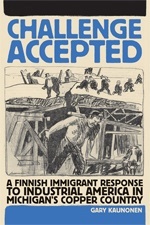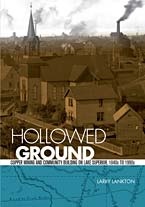 By ERIC FREEDMAN
By ERIC FREEDMAN
Capital News Service
LANSING – From the miners who dug copper ore from the frigid depths of the Upper Peninsula to the youthful governor who may deserve redemption from the scarlet letter of ignominy, new books are shedding light on Michigan’s past.
In illuminating 150 years of connections between mining companies and communities on the Keweenaw Peninsula, Larry Lankton tracks the birth, boom and bust of the industry that once dominated the nation’s copper production.
When the last mines closed in the 1960s, thousands of workers were left jobless, tax revenue dried up, businesses shut down and families moved away, wrote Lankton, a Michigan Technological University history professor whose examination of the U.P. mining industry began with a 1978 National Park Service project at the Quincy Mine in Hancock. The mine site is now a popular tourist attraction.
“No economic activity on the Keweenaw stepped in to take the core role once played by the mining industry,” he said in “Hollowed Ground: Copper Mining and Community Building on Lake Superior, 1840s-1990s” (Wayne State University Press, $34.95).
Even so, the book points to some lingering advantages of the now-defunct copper operations, including historic preservation and tourism. “Perhaps only the natural environment benefited from the economic decline,” he wrote.
Meanwhile, Gary Kaunonen, a graduate student at MTU, takes a different approach to mining in the U.P.
He focuses on the immigrants from Finland who, with others from elsewhere in Europe, worked in the mines, and the strife between labor and management.
“Challenge Accepted: A Finnish Immigrant Response to Industrial America in Michigan’s Copper Country” (Michigan State University Press, $39.95) culminates with a bitter 1913-14 strike.
Almost a century later, the strike is most remembered for tragedy, not for the underlying conflict over unionization and the Finnish workers’ socialist philosophy. That tragedy killed almost 80 people at a crowded Christmas Eve party for multiethnic strikers and their families at Italian Hall in Calumet.
The victims were trampled to death when someone believed to be a management provocateur who falsely yelled “fire” at the party.
Finally, consider the story of John Swainson as a lesson about how perceptions of Michigan history can change.
Swainson, a severely injured World War II veteran, was elected in 1960 as the state’s youngest governor since the 1830s. Although he lost a bid for a second term, he was later elected to the state Supreme Court.
But his judicial career nose-dived with the 1975 federal indictment accusing him of perjury and bribery. Naïve enough to hire a civil rather than criminal defense lawyer for the trial, he was convicted of lying to the grand jury.
Thus Swainson lost his judgeship, his law license, his sobriety and most importantly, his reputation. Although he later served as president of the Michigan Historical Commission, his reputation never fully recovered.
 But a new book by Lawrence Glazer, a former Ingham County judge and legal adviser to Gov. James Blanchard, strongly suggests that Swainson was wrongfully convicted.
But a new book by Lawrence Glazer, a former Ingham County judge and legal adviser to Gov. James Blanchard, strongly suggests that Swainson was wrongfully convicted.
“Wounded Warrior” (Michigan State University Press, $39.95) doesn’t go as far as saying Swainson was absolutely innocent. However, Glazer attributes the conviction to Swainson’s confusion during his grand jury testimony, the incompetence of his lawyer and the self-interest of the key prosecution witness against him.
“Few have been as worldly and yet as ingenuous as John Swainson,” Glazer writes. “Few have paid a higher price.”
© 2010, Capital News Service, Michigan State University School of Journalism. Not to be reproduced without permission.
Spartan Newsroom - News and information from student journalists at the Michigan State University School of Journalism
Spartan Newsroom (https://news.jrn.msu.edu/2010/11/new-histories-mine-copper-country-disgraced-governor/)